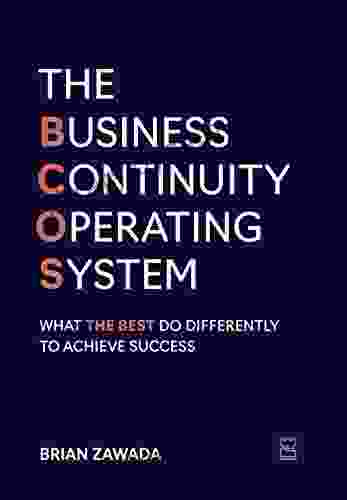The Business Continuity Operating System: Your Guide to Building a Resilient Organization

4.7 out of 5
| Language | : | English |
| File size | : | 1432 KB |
| Text-to-Speech | : | Enabled |
| Screen Reader | : | Supported |
| Enhanced typesetting | : | Enabled |
| Word Wise | : | Enabled |
| Print length | : | 267 pages |
| Lending | : | Enabled |
In today's complex and interconnected world, businesses face a growing number of threats that can disrupt their operations. From natural disasters to cyber attacks to supply chain disruptions, businesses need to be prepared to respond to any type of event that could impact their ability to operate.
The Business Continuity Operating System (BCOS) is a comprehensive guide to building a resilient organization. It provides step-by-step instructions for creating a business continuity plan and implementing it in your organization. The BCOS is based on the latest research and best practices in business continuity management, and it has been proven to help organizations reduce the impact of disruptions and recover quickly.
What is the Business Continuity Operating System?
The BCOS is a framework for creating a comprehensive business continuity plan. It consists of five key components:
- Risk assessment: The first step in creating a business continuity plan is to identify the risks that could disrupt your business. This includes both internal risks (such as equipment failures or employee absences) and external risks (such as natural disasters or cyber attacks).
- Business impact analysis: Once you have identified the risks that could disrupt your business, you need to assess the potential impact of each risk. This will help you prioritize your resources and develop strategies for mitigating the impact of disruptions.
- Business continuity plan: The business continuity plan is the heart of the BCOS. It outlines the steps that your organization will take to respond to and recover from a disruption.
- Testing and exercising: Regular testing and exercising of your business continuity plan is essential to ensure that it is effective. This will help you identify any weaknesses in your plan and make necessary improvements.
- Maintenance and improvement: Your business continuity plan is a living document that should be reviewed and updated regularly. This will ensure that your plan remains relevant and effective.
Benefits of the Business Continuity Operating System
Implementing the BCOS can provide a number of benefits for your organization, including:
- Reduced downtime: By having a plan in place to respond to disruptions, you can reduce the amount of downtime that your organization experiences. This can help you avoid lost revenue, damage to your reputation, and loss of customers.
- Improved customer satisfaction: Customers are more likely to do business with organizations that are prepared to respond to disruptions. By having a BCOS in place, you can demonstrate to your customers that you are committed to providing them with uninterrupted service.
- Enhanced employee morale: Employees are more likely to be satisfied with their jobs if they know that their organization is prepared to respond to disruptions. By having a BCOS in place, you can create a more stable and secure workplace for your employees.
- Reduced insurance costs: Some insurance companies offer discounts to organizations that have a BCOS in place. This can help you save money on your insurance premiums.
How to Implement the Business Continuity Operating System
Implementing the BCOS can be a complex process, but it is essential for any organization that wants to be resilient to disruptions. The following steps will help you get started:
- Get buy-in from leadership: The first step is to get buy-in from your organization's leadership. This is essential for ensuring that you have the resources and support you need to implement the BCOS.
- Form a team: Assemble a team of people from across your organization to help you implement the BCOS. This team should include representatives from all levels of the organization, including operations, finance, human resources, and IT.
- Identify risks: The next step is to identify the risks that could disrupt your business. This can be done by conducting a risk assessment. The risk assessment should include a review of your organization's physical assets, its IT infrastructure, and its supply chain.
- Assess the impact of risks: Once you have identified the risks that could disrupt your business, you need to assess the potential impact of each risk. This will help you prioritize your resources and develop strategies for mitigating the impact of disruptions.
- Develop a business continuity plan: The next step is to develop a business continuity plan. The plan should outline the steps that your organization will take to respond to and recover from a disruption. The plan should be tailored to the specific risks that your organization faces.
- Test and exercise the plan: Regular testing and exercising of your business continuity plan is essential to ensure that it is effective. This will help you identify any weaknesses in your plan and make necessary improvements.
- Maintain and improve the plan: Your business continuity plan is a living document that should be reviewed and updated regularly. This will ensure that your plan remains relevant and effective.
The Business Continuity Operating System is a comprehensive guide to building a resilient organization. By following the steps outlined in this article, you can implement a BCOS in your organization and protect your business from the impact of disruptions.
Free Download your copy of The Business Continuity Operating System today!
4.7 out of 5
| Language | : | English |
| File size | : | 1432 KB |
| Text-to-Speech | : | Enabled |
| Screen Reader | : | Supported |
| Enhanced typesetting | : | Enabled |
| Word Wise | : | Enabled |
| Print length | : | 267 pages |
| Lending | : | Enabled |
Do you want to contribute by writing guest posts on this blog?
Please contact us and send us a resume of previous articles that you have written.
 Book
Book Novel
Novel Page
Page Chapter
Chapter Text
Text Story
Story Genre
Genre Reader
Reader Library
Library Paperback
Paperback E-book
E-book Magazine
Magazine Newspaper
Newspaper Paragraph
Paragraph Sentence
Sentence Bookmark
Bookmark Shelf
Shelf Glossary
Glossary Bibliography
Bibliography Foreword
Foreword Preface
Preface Synopsis
Synopsis Annotation
Annotation Footnote
Footnote Manuscript
Manuscript Scroll
Scroll Codex
Codex Tome
Tome Bestseller
Bestseller Classics
Classics Library card
Library card Narrative
Narrative Biography
Biography Autobiography
Autobiography Memoir
Memoir Reference
Reference Encyclopedia
Encyclopedia Robert Bresson
Robert Bresson Walter H Gmelch
Walter H Gmelch Matthew Katzer
Matthew Katzer Robert Lindsey
Robert Lindsey Ronald Rompkey
Ronald Rompkey Peter Benjaminson
Peter Benjaminson Lelia O V Hinton Crowders
Lelia O V Hinton Crowders Kirk Deeter
Kirk Deeter Verne Harnish
Verne Harnish Terry Smith
Terry Smith Ryan Hartwig
Ryan Hartwig Natalie Rhodes
Natalie Rhodes Mark Stevens
Mark Stevens William Silvers
William Silvers Mark Farnsworth
Mark Farnsworth Sarah Jackson
Sarah Jackson Tristan Sandler
Tristan Sandler Robert Rath
Robert Rath Mike Matheny
Mike Matheny Maria Morukian
Maria Morukian
Light bulbAdvertise smarter! Our strategic ad space ensures maximum exposure. Reserve your spot today!

 Chadwick PowellUnleash the Power of Social Selling: Transform Your Sales Strategy with 'The...
Chadwick PowellUnleash the Power of Social Selling: Transform Your Sales Strategy with 'The...
 Jeremy MitchellThe Picture of Dorian Gray: A Haunting Exploration of Beauty, Vanity, and the...
Jeremy MitchellThe Picture of Dorian Gray: A Haunting Exploration of Beauty, Vanity, and the... Norman ButlerFollow ·3.9k
Norman ButlerFollow ·3.9k Derek CookFollow ·3.7k
Derek CookFollow ·3.7k John Dos PassosFollow ·8.3k
John Dos PassosFollow ·8.3k Douglas FosterFollow ·10.4k
Douglas FosterFollow ·10.4k Herman MitchellFollow ·15.4k
Herman MitchellFollow ·15.4k Sidney CoxFollow ·7.3k
Sidney CoxFollow ·7.3k Kyle PowellFollow ·6.4k
Kyle PowellFollow ·6.4k F. Scott FitzgeraldFollow ·2.1k
F. Scott FitzgeraldFollow ·2.1k

 Clay Powell
Clay PowellDiscover the Enigmatic Beauty and Profound Meaning in...
An Exploration of Emptiness, Fulfillment,...

 Brenton Cox
Brenton CoxThe Life and Times of the Woman Who Changed Abortion: The...
Norma McCorvey, the woman known...

 Darius Cox
Darius CoxBest 60 Short Hairstyles For Women With Thick Hair: A...
Embracing the beauty of...

 John Parker
John ParkerThe Healthy Pregnancy Book: Your Essential Guide to a...
Pregnancy is a...
4.7 out of 5
| Language | : | English |
| File size | : | 1432 KB |
| Text-to-Speech | : | Enabled |
| Screen Reader | : | Supported |
| Enhanced typesetting | : | Enabled |
| Word Wise | : | Enabled |
| Print length | : | 267 pages |
| Lending | : | Enabled |












